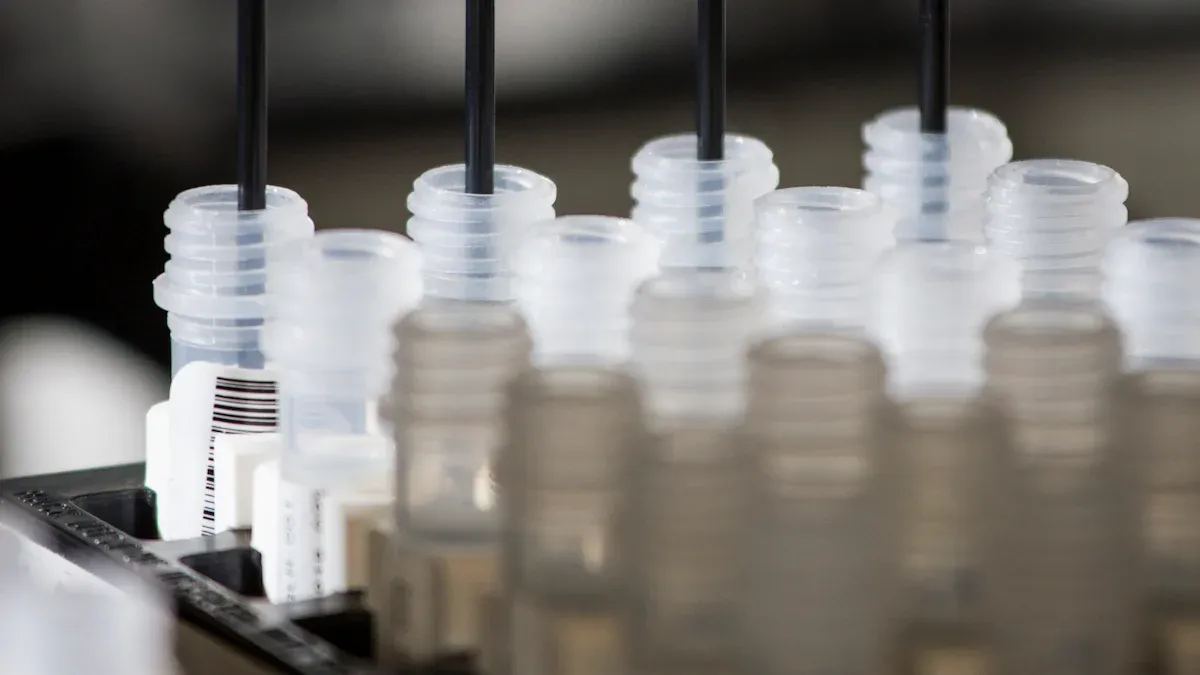Understanding CRISPR and Its Role in Modern Diagnostics

CRISPR, short for Clustered Regularly Interspaced Short Palindromic Repeats, is a groundbreaking technology that has transformed modern diagnostics. It enables precise detection of genetic material, making it a powerful tool for identifying diseases at their earliest stages. Unlike traditional methods, CRISPR diagnostics offer unmatched accuracy and sensitivity.
It minimizes false positives and negatives by targeting specific genetic sequences.
It detects even trace amounts of genetic material, crucial for early intervention.
It delivers faster results, essential during outbreaks like COVID-19.
It can test for multiple pathogens or markers simultaneously, saving time and resources.
CRISPR-based tools like SHERLOCK and DETECTR have revolutionized disease detection, offering rapid, reliable, and cost-effective solutions for conditions ranging from infectious diseases to cancer. This innovation represents a leap forward in understanding the role of CRISPR in next-level diagnostics.
Key Takeaways
CRISPR tests are very accurate. They find exact genetic parts, lowering mistakes.
This helps find diseases early, leading to faster treatment and better health.
CRISPR gives results quicker than older methods, helping during health crises.
It can check for many diseases at once, saving time and money.
CRISPR is useful in other areas too, like checking the environment and supporting green practices.
Understanding the Role of CRISPR in Next-Level Diagnostics

What is CRISPR?
CRISPR stands for Clustered Regularly Interspaced Short Palindromic Repeats. It is a natural defense system found in bacteria. This system helps bacteria protect themselves from viruses by targeting and cutting specific DNA sequences. Scientists have adapted this mechanism to create tools for genetic research and diagnostics.
CRISPR diagnostics uses guide RNA (gRNA) to locate specific DNA or RNA sequences.
The Cas9 enzyme, directed by the gRNA, cuts the DNA at precise locations.
This process allows you to identify disease-related genetic material with high accuracy.
By using CRISPR, you can detect diseases earlier and more reliably than traditional methods. This innovation has made it a cornerstone of next-level diagnostics.
How CRISPR Works in Diagnostics
CRISPR works by identifying and cutting specific genetic sequences. In diagnostics, it uses a guide RNA to search for the genetic material of pathogens or disease markers. Once the gRNA finds its target, it activates a Cas protein, such as Cas9 or Cas12. This protein cuts the DNA or RNA at the target site.
The cutting action generates a signal that you can detect using specialized equipment. For example, CRISPR-based tools like SHERLOCK and DETECTR use this mechanism to identify diseases like COVID-19 or genetic disorders. These tools are fast, accurate, and adaptable, making them ideal for modern diagnostics.
CRISPR's Molecular Mechanism for Disease Detection
At the molecular level, CRISPR diagnostics relies on the interaction between gRNA and Cas proteins. The gRNA binds to a specific nucleic acid sequence, such as the genetic material of a virus. This binding activates the Cas protein, which then cleaves nearby molecules.
The cleavage process releases a detectable signal, often through a fluorescent or colorimetric change. This signal confirms the presence of the target sequence. For example, if you are testing for a virus, the signal indicates that the virus's genetic material is present. This precise mechanism ensures that CRISPR-based diagnostics are both sensitive and reliable.
Advantages of CRISPR in Diagnostics
Precision and Sensitivity
CRISPR diagnostics stand out for their exceptional precision and sensitivity. By using enzymatic recognition, CRISPR tools can identify specific genetic sequences with unmatched accuracy. This high specificity minimizes the chances of false positives or negatives, ensuring reliable results. For example, tools like SHERLOCK and DETECTR have demonstrated sensitivity comparable to traditional PCR methods, making them highly effective for early disease detection.
You benefit from CRISPR's ability to detect even trace amounts of genetic material. This capability is crucial for identifying diseases in their earliest stages, where intervention can make the most difference. Whether you're testing for infectious diseases or genetic disorders, CRISPR ensures that no critical detail is overlooked.
Speed and Cost-Effectiveness
CRISPR-based diagnostics offer faster results compared to traditional methods. Signal amplification techniques allow you to obtain results in a fraction of the time required for PCR tests. This speed is particularly valuable during outbreaks, where rapid detection can save lives.
In addition to speed, CRISPR diagnostics are cost-effective. They rely on isothermal reactions, which eliminate the need for expensive thermal cycling equipment. This compatibility with low-cost form factors makes CRISPR accessible for point-of-care testing. Technologies like SHERLOCK and DETECTR exemplify this advantage, providing affordable and efficient solutions for a wide range of diseases.
Versatility Across Diagnostic Applications
CRISPR's versatility makes it a game-changer in diagnostics. Its programmability allows you to adapt it for various nucleic acid targets, enabling broad applicability. For instance, CRISPR has been used to detect infectious diseases like tuberculosis and malaria, as well as biomarkers in cancer diagnostics.
In cancer diagnostics, CRISPR enhances personalized medicine by identifying specific genetic alterations in tumor DNA. This information helps healthcare providers tailor treatments to the unique genetic profile of a patient's cancer, improving therapeutic outcomes. The adaptability of CRISPR ensures its relevance across diverse diagnostic applications, from infectious diseases to genetic and oncological conditions.
CRISPR's ability to combine precision, speed, and versatility positions it as a cornerstone of next-level diagnostics.
Current Applications of CRISPR in Diagnostics

Detecting Infectious Diseases
CRISPR has become a vital tool for detecting infectious diseases. It allows you to identify pathogens with high sensitivity and specificity. Tools like SHERLOCK and DETECTR have proven effective in diagnosing diseases such as COVID-19. These tools work quickly, providing results comparable to PCR tests but in less time.
Researchers have also adapted CRISPR to detect other pathogens, including Mycobacterium tuberculosis and Plasmodium species, which cause tuberculosis and malaria, respectively. The following table highlights the effectiveness of CRISPR-based technologies in detecting infectious diseases:
Study/Technology | Effectiveness | Notes |
|---|---|---|
SHERLOCK | High sensitivity and specificity | Adapted for SARS-CoV-2 detection |
DETECTR | High sensitivity and specificity | Comparable to PCR, rapid results |
Mycobacterium tuberculosis detection | Promising results | Effective for pathogen diagnosis |
Plasmodium species detection | New tool for malaria diagnosis | Successful in patient blood samples |
These advancements demonstrate how CRISPR enhances your ability to diagnose infectious diseases quickly and accurately.
Screening for Genetic Disorders
CRISPR diagnostics have transformed how you screen for genetic disorders. The technology offers unmatched specificity and sensitivity, enabling you to detect genetic abnormalities with precision. It also supports multiplexed detection, allowing you to screen for multiple diseases or genetic markers simultaneously.
CRISPR diagnostics enhance specificity, sensitivity, and speed in detecting genetic disorders.
The technology allows for multiplexed detection, enabling simultaneous screening for multiple diseases or genetic markers.
Integration with machine learning improves accuracy and automates analysis.
By combining these capabilities, CRISPR ensures that you can identify genetic disorders early, paving the way for timely interventions and personalized treatments.
Advancements in Cancer Diagnostics
CRISPR has revolutionized cancer diagnostics by enabling the detection of cancer-specific biomarkers. These biomarkers, found in circulating tumor DNA (ctDNA), are crucial for early detection and monitoring. CRISPR-based assays provide accurate results, helping you identify cancer at its earliest stages.
The development of portable diagnostic tools has further advanced cancer diagnostics. These tools allow you to perform tests quickly and efficiently in clinical settings. By integrating CRISPR with other technologies, researchers have improved the accuracy and speed of cancer detection. This progress highlights CRISPR's role in advancing next-level diagnostics and improving patient outcomes.
Challenges in CRISPR-Based Diagnostics
Cost and Accessibility Barriers
CRISPR-based diagnostics face significant cost and accessibility challenges. The development and implementation of these tools require substantial financial investment. For example, the cost of Casgevy treatment, a CRISPR-based therapy, reaches approximately $2 million per patient. While diagnostic tools may not reach this price point, they still face affordability issues, especially in low-resource settings.
Limited access to advanced technology further complicates the situation. Many healthcare facilities lack the infrastructure needed to implement CRISPR diagnostics effectively. This gap creates disparities in access, leaving underserved populations without the benefits of these cutting-edge tools.
Ensuring affordability and widespread availability of CRISPR diagnostics remains a critical hurdle for global healthcare systems.
Regulatory and Ethical Concerns
Navigating regulatory pathways for CRISPR diagnostics is a complex and time-consuming process. Regulatory bodies require extensive testing to ensure the safety and efficacy of these tools. This process delays their availability and increases costs.
Ethical concerns also play a significant role. Questions about the misuse of CRISPR technology, such as enhancing human traits, raise public apprehension. Privacy concerns regarding genetic data further complicate its adoption.
Aspect | Details |
|---|---|
Regulatory Approval | CRISPR diagnostics must navigate complex regulatory approval pathways to ensure safety and efficacy. |
Ethical Considerations | Addressing potential misuse and privacy concerns is vital for public trust and acceptance. |
You must also consider the implications of editing the human germline. This raises questions about long-term effects on future generations and the morality of such interventions.
Technical and Scalability Issues
CRISPR diagnostics face technical challenges that hinder their scalability. Developing tools that maintain high precision and sensitivity while being cost-effective is difficult. Scaling these tools for widespread use requires significant technological advancements.
Operational challenges include ensuring consistent performance across diverse healthcare settings. For example, tools like SHERLOCK and DETECTR must adapt to varying resource levels while maintaining accuracy. These issues highlight the need for further research and innovation to make CRISPR diagnostics more practical and scalable.
Overcoming these technical and scalability barriers is essential for CRISPR diagnostics to reach their full potential.
The Future of CRISPR in Modern Diagnostics
Personalized Medicine and CRISPR
CRISPR is paving the way for personalized medicine by tailoring treatments to your unique genetic makeup. It allows healthcare providers to identify specific genetic mutations that influence how you respond to certain therapies. For example, in cancer care, CRISPR can detect mutations in tumor DNA, helping doctors design treatments that target those mutations directly. This approach improves treatment outcomes and reduces side effects.
You also benefit from CRISPR's ability to screen for genetic predispositions to diseases. Early detection of these risks enables preventive measures, such as lifestyle changes or targeted therapies. By integrating CRISPR into personalized medicine, healthcare becomes more precise, proactive, and patient-centered.
Integration with Emerging Technologies
CRISPR's potential grows even further when combined with emerging technologies. Platforms like SHERLOCK and DETECTR already demonstrate how CRISPR integrates with point-of-care devices for rapid and accurate diagnostics. These tools allow you to test for multiple diseases simultaneously, making them invaluable in resource-limited settings.
Other technologies, such as artificial intelligence (AI) and machine learning, enhance CRISPR's diagnostic capabilities. AI can analyze large datasets generated by CRISPR tests, identifying patterns and improving accuracy. Additionally, portable diagnostic devices powered by CRISPR bring advanced testing to remote areas, ensuring broader access to healthcare.
The fusion of CRISPR with cutting-edge technologies transforms diagnostics into a faster, more accessible, and more efficient process.
Expanding Beyond Human Health
CRISPR's applications extend far beyond human health. In environmental diagnostics, it detects harmful pathogens in water and soil, helping you monitor and maintain ecological balance. In manufacturing, CRISPR-engineered microbes improve production processes, such as enhancing the yield and quality of beer.
Efforts in sustainability also benefit from CRISPR. Genome engineering creates carbon-neutral production methods, reducing greenhouse gas emissions and waste. Ecological engineering projects use CRISPR to eliminate invasive species or even revive extinct ones, like the woolly mammoth.
Diagnostics: Identifies environmental pathogens.
Manufacturing: Boosts efficiency in industrial processes.
Sustainability: Promotes eco-friendly production methods.
Ecological Engineering: Aims to restore biodiversity.
CRISPR's versatility ensures its impact reaches far beyond medicine, addressing global challenges in sustainability and conservation.
CRISPR has transformed diagnostics by offering precision, speed, and versatility. It minimizes errors, detects diseases early, and enables simultaneous testing for multiple conditions. You can see its impact in applications like infectious disease detection, genetic disorder screening, and cancer diagnostics.
Advantage/Application | Description |
|---|---|
Targets disease-related genetic sequences with precision. | |
Early Detection | Identifies minute genetic material for timely intervention. |
Speed of Results | Delivers faster outcomes, crucial during outbreaks. |
Personalized Medicine | Improves treatment by identifying genetic mutations in diseases like cancer. |
Overcoming challenges like cost and accessibility will unlock CRISPR's full potential. With continued innovation, you can expect CRISPR to redefine diagnostics and improve global healthcare.
FAQ
What makes CRISPR different from traditional diagnostic methods?
CRISPR targets specific genetic sequences with unmatched precision. Traditional methods often rely on broader detection techniques, which can lead to errors. CRISPR minimizes false positives and negatives, ensuring reliable results. Its speed and adaptability also make it superior for modern diagnostics.
Can CRISPR detect multiple diseases at once?
Yes, CRISPR can test for multiple diseases simultaneously. By programming guide RNAs for different targets, you can identify various pathogens or genetic markers in one test. This saves time and resources, especially in outbreak scenarios.
Is CRISPR-based testing affordable?
CRISPR diagnostics are more cost-effective than many traditional methods. They use simpler equipment, reducing expenses. However, initial development costs can be high. Efforts are ongoing to make these tools more accessible in low-resource settings.
How safe is CRISPR technology in diagnostics?
CRISPR is highly safe when used for diagnostics. It does not alter your DNA but only detects specific genetic material. Researchers rigorously test CRISPR-based tools to ensure accuracy and safety before clinical use.
Can CRISPR be used outside of healthcare?
Yes, CRISPR has applications beyond healthcare. It detects environmental pathogens, monitors food safety, and even aids in agricultural research. Its versatility makes it valuable across various industries.
See Also
A Comprehensive Guide To Glioblastoma And Its Features
An Overview Of Craniopharyngioma And Its Main Traits
B-Cell Prolymphocytic Leukemia: A Simplified Explanation
